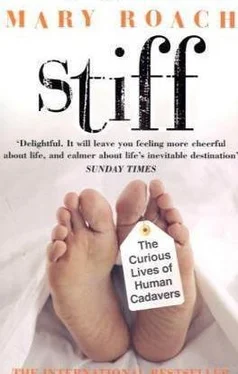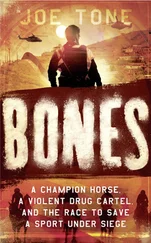It is a condition called “flail chest,” and people die from it.
Flail chest is one of the other things that make side impacts especially dangerous. Ribs are easier to break from the side. The rib cage is built to be compressed from the front, sternum to spine—that’s how it moves when you breathe. (Up to a point, that is. Compress it too far and you can, in the words of Don Huelke, “split the heart completely in half as you would a pear.”) A rib cage is not built for the sideways press. Slam it violently from the side, and its tines tend to snap.
Matt is still working on the setup. Deb is intent on her accelerometers.
Normally, accelerometers are screwed into place, but if she were to screw them into the bone, the bone would be weakened and would break more easily in the impact. Instead she secures them to the bone with wire ties and then wedges wood scrims underneath to tighten the fit. As she works, she slips the wire cutters into and out of the cadaver’s mittened hand, as though he were a surgical nurse. Another way for him to help.
With the radio playing and the three of us talking, the room has a feeling of late-night congeniality. I find myself thinking that it’s nice for UM 006 to have company. There can be no lonelier state of being than that of being a corpse. Here, in the lab, he’s part of something, part of the group, the center of everyone’s attention. Of course, these are stupid thoughts, for UM 006 is a mass of tissue and bone who can no more feel loneliness than he can feel Marth’s fingers probing the flesh around his collarbone.
But that’s how I feel about it at the moment.
It is past nine now. UM 006 has begun to put out a subtle gamy smell, the mild but unmistakable fetor of a butcher shop on a hot afternoon. “How long,” I ask, “can he stay out at room temperature before he starts to…” Marth waits for me to finish my sentence. “…change?” She says maybe half a day. She is looking put-upon. The ties aren’t tight enough and the Krazy Glue’s not crazy anymore. It’s going to be a long night.
John Cavanaugh calls down that there’s pizza upstairs, and the three of us, Deb, Matt Mason, and I, leave the dead man by himself. It feels a little rude.
On the way upstairs, I ask Deb how she wound up working with dead bodies for a living. “Oh, I always wanted to do cadaver research,” she says, with exactly the same enthusiasm and sincerity with which a more usual individual would say “I always wanted to be an archaeologist” or “I always wanted to live by the sea.”
“John was so psyched. Nobody wants to do cadaver research.” In her office, she takes a bottle of a perfume called Happy from a desk drawer.
“So I smell something else,” she explains. She has promised to give me some papers, and while she searches for them I look at a pile of snapshots on her desk. And then, very quickly, I don’t. The photographs are close-ups from a previous cadaver’s shoulder autopsy: meaty red and parted skin. Matt looks down at the pile. “These aren’t your vacation shots, are they, Deb?”
By half past eleven, all that remains is to get UM 006 into driving posture.
He is slumped and leaning to one side. He is the guy next to you on the plane, asleep and inching closer to your shoulder.
John Cavanaugh takes the cadaver by the ankles and pushes back on him, to try to get him to sit up in the seat. He steps back. The cadaver slides back toward him. He pushes him again. This time he holds him while Matt encircles UM 006’s knees and the entire circumference of the car seat with duct tape. “This probably won’t make it into the ‘101 Uses’ list,” observes Matt.
“His head’s wrong,” says John. “It needs to be straight ahead.” More duct tape. The radio is playing the Romantics, “That’s What I Like About You.”
“He’s slumping again.”
“Try the winch?” Deb loops a canvas strap under his arms and presses a button that raises a ceiling-mounted motor winch. The cadaver shrugs, slowly, and holds it, like a Borscht Belt comedian. He lifts slightly from his seat, and is lowered back down, sitting straighter now. “Good, perfect,” says John.
Everyone steps back. UM 006 has a comic’s timing. He waits a beat, two beats, then slips forward again. You have to laugh. The absurdity of the scene and the punch-drunk hour are making it hard not to. Deb gets some pieces of foam to prop up his back, which seems to do the trick.
Matt runs a final check of the connections. The radio—I’m not making this up—is playing “Hit Me with Your Best Shot.” Five more minutes pass. Matt fires the piston. It sounds a loud bang as it shoots out, though the impact itself is silent. UM 006 falls over, not like a villain shot in a Hollywood movie, but slowly, like an off-balance laundry sack. He falls over onto a foam pad that has been set out for this purpose, and John and Deb step forward to steady him. And that’s that. Without the screech of skidding tires and the crunch and fold of metal, an impact is neither violent nor disturbing. Distilled to its essence, controlled and planned, it is now simply science, no longer tragedy.
The family of UM 006 does not know what happened to him this evening.
They know only that he donated his remains for use in medical education or research. There are many reasons for this. At the time a person or his family decides to donate his remains, no one knows what those remains will be used for, or even at which university. The body goes to a morgue facility at the university to which it was donated, but may be shipped, as was UM 006, from that school to another.
For a family to be fully informed of what is happening to their loved one, the information would have to come from the researchers themselves, after they’ve taken receipt of the body (or body part) but before they run their test. As a result of the subcommittee hearings, that was sometimes done. Automotive impact researchers who received federal NHTSA funding and who had not made it clear in their willed body consent forms that the remains might be used for research were required to contact families prior to the experiment. According to Rolf Eppinger, chief of the NHTSA Biomechanics Research Center, it was rare for the family to renege on the deceased’s consent.
I spoke with Mike Walsh, who worked for one of NHTSA’s main contractors, Calspan. It was Walsh who, once the body arrived, called the family to set up a meeting—preferably, owing to the highly perishable state of unembalmed remains, within a day or two after the death. You would think, as principal investigator on these studies, that Walsh would have delegated the enormously uncomfortable task to someone else. But Walsh preferred to do it himself. He told the families precisely how their loved one would be used and why. “The entire program was explained to them. Some studies were sled impact studies, some were pedestrian impact studies, [15] To quote a Stapp Car Crash Conference study on the topic, “Pedestrians are not ‘run over’ by cars. They are ‘run under.’” It typically goes like this: Bumper hits calf and front of hood hits hip, knocking the legs out from under and flipping them up over the head. The cartwheeling pedestrian then lands on his head or chest on the hood or windshield. Depending on the speed of the impact, he may continue cartwheeling, legs over head again, and land flat on the roof, and from there slide off onto the pavement. Or he may remain on the hood, with his head smashed through the windshield. Whereupon the driver calls an ambulance, unless the driver is someone like Fort Worth nurse’s aide Chante Mallard, in which case she keeps on driving, returns to her house, and allegedly leaves the car in the garage with the victim sticking out of her windshield until he bleeds to death. This event took place in October 2001. Mallard was arrested and charged with murder.
some were in full-scale crash vehicles.” Clearly Walsh has a gift. Out of forty-two families contacted, only two revoked consent—not because of the nature or specifics of the study, but because they had thought the body was going to be used for organ donation.
Читать дальше












